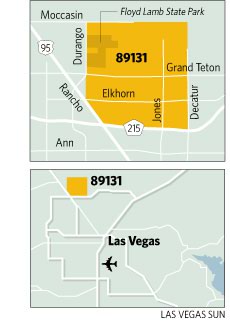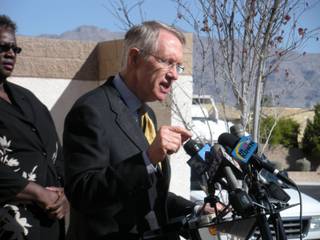
Neal and Michelle Williams, who have owned their Las Vegas home for 13 years, have seen their neighborhood deteriorate as the ZIP code has developed one of the highest foreclosure rates in the nation.
Thursday, March 26, 2009 | 2 a.m.
Sun Topics
Sun Archives
- Housing help for Nevadans in budget bill (3-25-2009)
- Report: Las Vegas home values fall 28 percent in year (3-24-2009)
- Reid: Obama housing plan not enough (3-23-2009)
- Whether to walk away: Housing's moral minefield (3-22-2009)
- Professionals pessimistic about speedy economic recovery (3-20-2009)
- LV reclaims top foreclosure ranking in U.S. (3-20-2009)
- Reid, Goodman tour foreclosed homes, present remedy (10-22-2008)
Maria Kriegh’s two daughters signed up about 20 neighbors for Girl Scout cookies in late February, but when they returned to deliver the boxes two weeks later, the mother of four was shocked to find that a few of the homes were empty, bare living rooms glimpsed through window panes.
The Kriegh family lives on Wandering Street, in ZIP code 89131 — ground zero for the nation’s foreclosure crisis.
The area was in the spotlight five months ago, when Senate Majority Leader Harry Reid, Las Vegas Mayor Oscar Goodman and federal officials stood behind a podium on the lawn of an empty house across the way on Moradi Avenue and announced a federal program called the Neighborhood Stabilization Plan.
The program is designed to help fix neighborhoods knocked asunder by the wave of foreclosures. It sends $70 million to Nevada, $20.6 million of which goes to nine ZIP codes in Las Vegas, including the one where the politicians spoke. They described 89131 as “the hardest-hit area in Southern Nevada in terms of foreclosures;” as of February, the Las Vegas metropolitan area had the highest foreclosure rate in the nation.
Now that the federal government has signed off on Neighborhood Stabilization plans for Las Vegas, North Las Vegas, Clark County and Henderson, grants are expected to be handed out by mid-May. In the case of Las Vegas, the largest amount, $7.3 million, will go to buying foreclosed houses and selling them to people who earn less than 120 percent of the area median income — up to $77,000 for a family of four. An estimated 245 families could be helped by the money.
But will that be enough, and soon enough, to stabilize a neighborhood like the one where Reid and Goodman stood? For that matter, what is it like to live at ground zero?
Kriegh looks back in time to answer the question. Her family was the last one to move onto the newly laid-out street in December 1996. Back then, it was nearly a rural idyll, a place where “my children could go outside and chase lizards.” Kriegh’s friend and real estate agent Beverly Ann Lacey was her neighbor. Lacey remembers the neighborhood as a “nice mix of middle to upper-middle class” families living in 1,500- to 2,200-square-foot houses; a place “where everybody was hoping for the best.”
Fast forward to the past year or so and Kriegh says the worst part is not just losing everyone except for three or four neighbors, many forced out by foreclosure, lost paychecks, or both. She says it is more than the gap-tooth geography that comes with double-digit foreclosure rates. She runs down a list of things she never saw in her neighborhood until a year ago: gas siphoned from pickup trucks in the streets and driveways, graffiti splashed on walls, punches landed against her 10-year-old boy’s face, shopping carts tossed into the street, carpenter’s tools snatched from a longtime neighbor’s truck across the way, gunshots popped in the night.
Kriegh says this list has grown as new people have moved into the neighborhood, renting houses that banks have foreclosed on and sold to investors.
She no longer lets her children out after dark. She is trying to rent out her family’s house and hopes Lacey can find them somewhere to move, far away.
A few houses down Moradi Avenue, Neal Williams has a ready description of the effect foreclosures have had on his neighborhood.
“Just look at this,” he says, pointing to a gate he is still installing, meant to protect the house he has owned for 13 years. “This should let you know how I feel about how things are going.”
The father of three and owner of a custom concrete company points upward to burglar alarm sensors he has put in on the wall overlooking the street. He has also recently put locks on the gas caps of his company trucks parked in the driveway. Williams has his own list: three bicycles stolen from his back yard, rocks tossed at bedroom windows, a gangbanger at school trying to talk his teenage son into stealing his own father’s guns.
As a business owner who depends on residential construction, Williams has taken one hit after another in the past two years, dropping from 81 to 23 employees and withholding his own salary some months. “We’re on the verge of losing everything,” he says.
Add to that the stress of seeing his neighborhood change before his eyes, and it is hard to see an end in sight. “I just don’t understand why the people moving in here don’t take care of their homes, of their neighborhood,” he says.
Lacey, the real estate agent who was Kriegh’s neighbor from 1997 to 2005, explains, “What has happened is you’re bringing in temporary residents, rental properties, people who are staying six months, one year, and then they leave. They don’t take care of the property, there’s no upkeep ... This opens the door for crime, the quality of life changes.”
In the current situation, “neighbors don’t know who the neighbors are; there’s no stability.”
So, what can the Neighborhood Stabilization Plan do?
Tim Whitright, development manager for Neighborhood Services Department of Las Vegas, will oversee the plan. He has put out a request for proposals from nonprofit organizations to administer the $7.3 million that will help hundreds of families move into houses. Federal rules require him to work with nine ZIP codes, the top five in numbers of foreclosures as of Dec. 1, when the city submitted its plan to the federal government for approval; and the top four in numbers of houses headed for foreclosure. As of Dec. 1, 89131 ranked third in the first category, with 1,515 foreclosed houses, behind 89108 and 89110.
Nonprofit organizations have until April 9 to send in their proposals; the money must be spent in 18 months.
After hearing of the conditions on the streets where politicians walked in October, Whitright says the stabilization plan is meant to get people into neighborhoods, taking care of their properties and streets, supporting local businesses.
“Our intent is to help address some of the collateral effects of the foreclosure crisis,” he said.
At the same time, he notes that “neither the free market nor government programs can control who moves into a neighborhood.”
Tabitha Hardy moved to Moradi Avenue with her three children in December 2007 in part because her former husband grew up nearby and described the area as “like a small town, where everybody knows everybody.”
But Hardy, who is an emergency medical technician, soon found that she didn’t even have a next-door neighbor. The house next to her went into foreclosure soon after she moved in and has been a magnet for vandals ever since. She has also endured loud parties throughout the neighborhood, cars driving by at all hours. And when she asks children who come over to play with her children if they’ve told their parents, they tell her their parents aren’t home. A staggering drunk stepfather did make it to Hardy’s door one time, to pick up his son. Hardy is disappointed in her neighborhood. “People aren’t caring anymore,” she says, attempting to describe what she thinks has been lost.
Would it help to have families moving into houses like the one next door, through the federally funded program?
“Any homeowner is more likely to care about his neighborhood,” she says. “Is it enough? I don’t know.”
In any case, she probably won’t be around to see. About two months ago she heard four gunshots outside. She called the police. And after officers took her report, she started looking for somewhere else to live.
A foreclosure ground zero ZIP code, she says, is “not what I wanted my children to grow up in.”



Join the Discussion:
Check this out for a full explanation of our conversion to the LiveFyre commenting system and instructions on how to sign up for an account.
Full comments policy